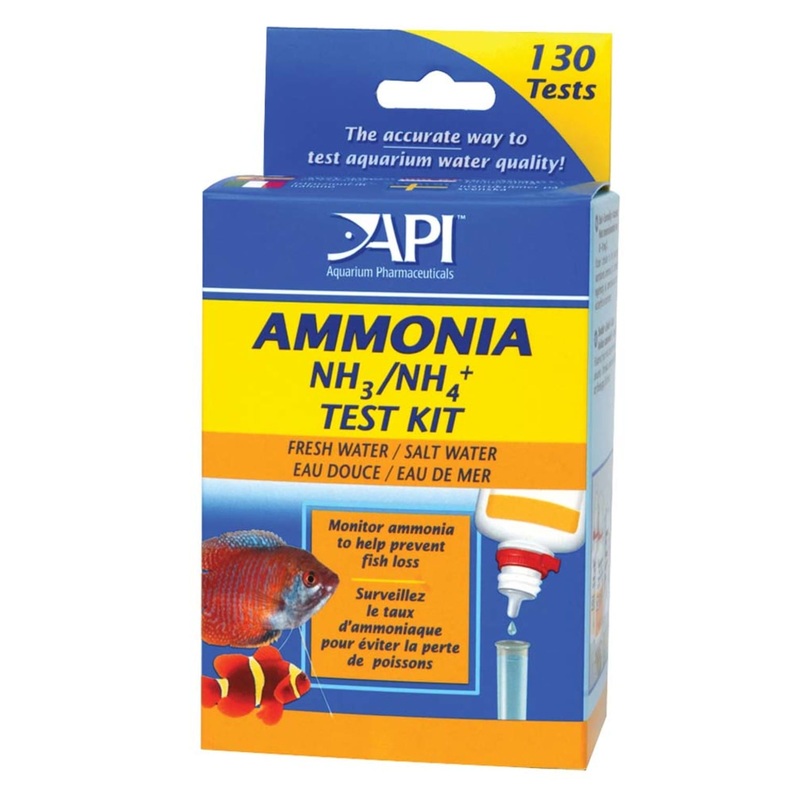

 Sale!
Sale! Salicylate test measures ammonia levels in both fresh & saltwater aquariums. Ammonia, the #1 killer of tropical fish, is continually produced in the aquarium from fish waste & uneaten fish food. This API test kit measures ammonia levels from 0 to 8 ppm. Wh
Salicylate test measures ammonia levels in both fresh & saltwater aquariums. Ammonia, the #1 killer of tropical fish, is continually produced in the aquarium from fish waste & uneaten fish food. This API test kit measures ammonia levels from 0 to 8 ppm.
Why test for Ammonia?
Tropical fish continually release ammonia (NH3) directly into the aquarium through their gills, urine, and solid waste. Uneaten food and other decaying organic matter also add ammonia to the water. A natural mechanism exists that controls ammonia in the aquarium the biological filter. It is made up of nitrifying bacteria, which live in the gravel bed. However, as with any natural process, imbalances can occur. Testing for the presence of toxic ammonia is essential, so that once detected, steps can be taken to remove it. Otherwise, ammonia in the aquarium will damage gill membranes, and prevent fish from carrying on normal respiration. High levels of ammonia quickly lead to fish death. Even trace amounts stress fish, suppressing their immune system and thereby increasing the likelihood of disease outbreaks and subsequent fish loss.
Testing Tips:
This salicylate based ammonia test kit reads the total ammonia level in parts per million (ppm) which are equivalent to milligrams per Liter (mg/L) from 0 ppm to 8.0 ppm (mg/L), in either fresh or saltwater aquariums. Thus, there are two Ammonia Test Color Charts one for freshwater aquariums, and one for saltwater aquariums so be sure to use the correct chart for your type of aquarium when interpreting test results. The Freshwater Ammonia Test Color Chart is the appropriate chart to use for testing freshwater aquariums to which salt has been added.
Directions for Testing Ammonia Levels
What the Test Results Mean:
In a new freshwater or saltwater aquarium, the ammonia level may surge to 6 ppm (mg/L) or more, and then fall rapidly as the biological filter becomes established. The ammonia will be converted to nitrite (also toxic), then to nitrate. This process may take several weeks. Use Aquarium Pharmaceuticals STRESS ZYME to speed up the development of the biological filter. In an established aquarium, the ammonia level should always remain at 0 ppm (mg/L). The presence of ammonia indicates possible over-feeding, too many fish, or inadequate biological filtration.
The ammonia level is not an indication of the nitrite level; nitrite is another toxic waste material which must be tested separately.
Monitoring Ammonia Levels:
Regular testing is necessary to make sure the ammonia level is safe. Aquarium water should be tested for ammonia every other day when the aquarium is first set up, and once a week after the biological filter has been established (in about 4 to 6 weeks).
Water Changes
Changing 25% of the aquarium water will reduce the ammonia level in emergency situations. In situations where animals are present, daily testing and water changes may be required over several days until ammonia levels fall naturally. The use of a bacterial cycling agent such as Stress Zyme to innoculate the aquarium, in conjunction with an ammonia-neutralizing water conditioner may also be beneficial.
Danger:
FAQs
The dropper tips are all the same, but the viscosity of the liquids are different. Drops may appear to be larger coming out due to the thickness of the drop.
Once the test has completed, it is important to rinse the test tube with water right away so that the contents dont stay in the test tube. This will make sure that the reagents dont cause anything to stick to the sides of the test tube, which could cause staining over time.
Simply run the water, open the test tube gently (do not twist the cap), and allow the water to dilute and rinse the contents out of the test tube. Avoid getting the contents of the test tube on your skin.
If you find that you have forgotten reagent within your test tube for a long period and the color is sticking to the tube, you are able to use a small bottle brush (and some API Safe & Easy cleaning spray) to gently wash the inside of the tube. Avoid the use of soap, as soap residue could be introduced back into the aquarium when filling the test tube at next use, which is something that could be harmful to your fish.
Replacement test tubes are also available for purchase from online retailers, should you need additional test tubes.
While it is important to shake the indicated reagent bottles very vigorously, you should be gentler when shaking the test tubes during testing. Before shaking, make sure that the cap is closed tight. Place a finger or thumb on top of the cap, to make sure it cannot come undone during use. The goal of this shaking step is to mix the contents of the tube together and this can be accomplished by simply inverting the test tube, back and forth every 1-2 seconds, for the indicated amount of time.
Standard Shipping
Cost: $25
Free Shipping
We offer free shipping on orders over $30. Please check the free - shipping eligibility at checkout.
Delivery Time:
It usually takes [3-5] business days for standard shipping. Please note that this is an estimated time frame and may be affected by local holidays, and unforeseen circumstances.
Reviews
There are no reviews yet.